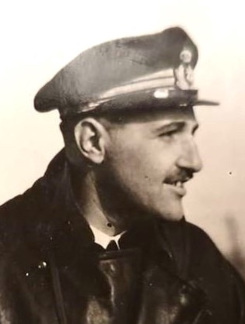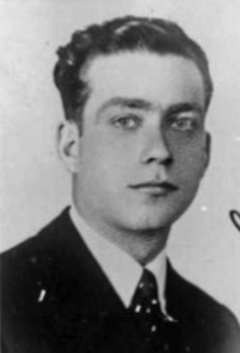Italian submarines in World War Two
Italian Commanders
Guido Saccardo
| Born | 20 May 1913 | Portici (Naples) | |
| Died | 15 Apr 1943 | (29) | Killed in action |
| Ranks
Decorations
|
Career information
LEONARDO DA VINCI (T.V. First Officer): from 23.08.1941 to March 1942+.ARCHIMEDE (T.V. C.O.): from 10.08.1942 to 15.04.1943 (sunk, Saccardo was killed).
Commands listed for Guido Saccardo
| Submarine | Type | Rank | From | To |
|---|---|---|---|---|
| Archimede (AH, I.31) | Ocean going | T.V. | 10 Aug 1942 | 15 Apr 1943 |
Ships hit by Guido Saccardo
| Date | Submarine | Ship hit | Type | GRT | Nat. | Loss type | |
|---|---|---|---|---|---|---|---|
| 1. | 9 Oct 1942 | Archimede | Oronsay | Troop transport | 20,043 | Sunk |
War patrols listed for Guido Saccardo
| Submarine | Date | Time | Port | Arr. date | Arr. time | Arr. port | Miles | Description | ||
|---|---|---|---|---|---|---|---|---|---|---|
| 1. | Archimede (AH, I.31) | 15 Sep 1942 | 1715 | La Pallice | 17 Nov 1942 | 1100 | Bordeaux | 9813 | Sailed with Bagnolini (a U-boat equipped with Metox for the Biscay passage was to accompany them but turned back because of defects) and patrolled near Freetown between 02°00'N and 04°00'N, and between 09°00'W 16°00'W. | |
| 18 Sep 1942 | 1500 | 44° 15'N, 8° 10'W | At 1500 hours, a submarine was sighted. Archimede dived. | |||||||
| 1 Oct 1942 | 1120 | 16° 15'N, 21° 30'W | At 1120 hours, smokes were sighted on the horizon, initially believed to be a convoy . Archimede made an enemy report, but it was not received by BETASOM. It was later proved to be only a lone steamer. The submarine closed submerged at 1553 hours but then recognised it to be the Spanish Mar Caribe (5,152 GRT, built 1920). The attack was aborted. | |||||||
| 9 Oct 1942 | 0720 0530Z (e) | 4° 08'N, 20° 57'W | At 0705 hours, in rainy weather, a large vessel was sighted steering 060° at a distance of 4,000 metres. Archimede attempted a snap attack with the stern tubes, but good not get a good position. At 0720 hours, two torpedoes (533mm, S.I. 270 type) were fired from bow tubes at a distance of 1,800-2,000 metres. After 140 seconds, one scored a hit on the starboard side. This was the troopship Oronsay (20,043 GRT, built 1925), traveling independently, on a return trip from Capetown where she had landed troops with convoy WS 21P. She was carrying 466 passengers and crew. At 0737 hours, another pair of torpedoes (533mm, S.I. 270 type) were fired from bow tubes at a distance 800-1,000 metres. Both missed. The first deviated to port and the second apparently missed ahead. At 0803 hours, a stern torpedo (450mm, W 200 type) was fired from 1,000-1,200 metres. It hit on the port side, but the troopship remained afloat. At 1008 hours, a pair of stern torpedoes (450mm, W 200 type) was fired from 1,000-1,200 metres. They both hit on the port side. The submarine observed about fifteen lifeboats and left the scene. Oronsay finally sank in the evening. Only six men were lost. The destroyer HMS Brilliant picked up 321 survivors (HMS Boreas was also sent to pick up survivors). The French sloop Dumont d'Urville picked up 47 survivors, the French steamer Lipari picked up another 19 survivors. | |||||||
| 9 Oct 1942 | 2327 2140Z (e) | 4° 05'N, 20° 15'W | At 2233 hours, a large vessel was observed in the rain at a distance of 4,000 metres, steering on a NW course at 16 knots. At 2327 hours, two torpedoes (533mm, S.I. 270 type) were fired at a range of 1,200 metres. T.V. Guido Saccardo believed he had scored at least a hit and the vessel was observed to move away at a reduced speed. At 0014 hours, a third torpedo (533mm, S.I. 270 type) was fired from a bow tube at a distance of 500 metres. It missed astern. Archimede had her bow tubes empty and had no time to reload. The vessel escaped. This was the British troopship Nea Hellas (16,691 GRT, built 1922) on return trip from convoy WS 22 (Capetown to Glasgow). She made an SOS, her signal mentioning that she had been hit in No.3 and No.4 holds. The crew was ready to abandon ship. It was realised that she was not hit and that torpedoes had passed astern so the signal was cancelled. It is probable that the magnetic pistols had detonated prematurely. The destroyer HMS Brilliant was ordered to the area to hunt the submarine and escort Nea Hellas to Freetown. | |||||||
| 11 Oct 1942 | 1802 | 6° 20'N, 23° 35'W | At 1802 hours, a German U-boat was sighted and exchanged recognition signals. | |||||||
| 19 Oct 1942 | 1400 | 7° 30'N, 19° 12'W | At 1400 hours, an aircraft was seen and the submarine dived. | |||||||
| 2. | Archimede (AH, I.31) | 14 Feb 1943 | Date??? | Bordeaux | 14 Feb 1943 | Date??? | Bordeaux | The submarine sailed from Bordeaux for Le Verdon with Da Vinci (?) and Bagnolini according to her lone survivor, but turned back due to defects. | ||
| 3. | Archimede (AH, I.31) | 26 Feb 1943 | Evening | Le Verdon | 15 Apr 1943 | 2140 | Sunk | ? | Sailed for patrol off the Brazilian coast. Carried sixteen torpedoes (ten 533mm and six 450 mm, the latter all astern). Sunk by two PBY-5A Catalina aircraft of 93rd Patrol Squadron (which belonged to the U.S. Navy Patrol and were part of VP-83) in 03°23'S, 30°28'W or 180 miles east of Fernando Noranha. Only one survivor was found after 27 days by Brazilian fishermen. According to her survivor, the submarine carried 10 x 533 mm torpedoes (made in Naples), six electric (G7e) and four magnetic, and 6 x 450 mm torpedoes (2 x 533 mm electric and 6 x 450 mm were aft, the remaining eight 533mm torpedoes were forward). Only sighted three neutral ships during her last patrol. | |
| 5 Apr 1943 | 1058P (e) | At 1700 hours, a Brazilian A-28 aircraft piloted by Tenente Ivo Castaldoni, while sweeping the area behind convoy TC-9, sighted an object believed to be a submarine and attacked with depth charges. Following the attack, some debris and an oil slick were seen. It was initially thought that this may have been Archimede (who did not return from her patrol), but later it was believed that the Brazilians had attacked the wreck of the Swedish Industria, sunk by U-518 (KL Friedrich-Wilhelm Wissmann) on 25th March. | ||||||||
| 15 Apr 1943 | 2140 1510P-1625P (e) | 3° 23'S, 30° 28'W | At 2140 hours, Archimede was surprised on the surface by two PBY-5A Catalina aircraft of 93rd Patrol Squadron (U.S. Navy). They were piloted respectively by Ensign T.E. Robertson, USN and Lieutenant Gerard Bradford Jr., USNR. The submarine was first sighted at a distance of 8 miles by Ensign Robertson. He made a stern attack and it was observed that the submarine was putting up antiaircraft fire. The Catalina dropped two demolition bombs and made a second run, dropping another pair of demolition bombs and two depth charges from a height of 2,000 feet. The submarine kept firing with two machine guns, one on the conning tower and one abaft the conning tower. The detonation of the bombs and depth charges completely hid the submarine from view. When the smoke cleared, the submarine circled for 15 minutes before resuming a straight course. The Catalina now circled the submarine at a distance of six miles while signalling other aircraft to home in. The submarine was now using her forward deck gun (100mm) to fire at least ten rounds at the Catalina. The Catalina flown by Lieutenant Bradford arrived on the scene and made two runs, dropping two depth charges each time. Ensign Roberston was about to make a third run when the submarine's bow was observed to take a 050° angle before disappearing. About thirty-five or forty survivors were observed struggling in the water and the Catalina dropped a seven-man raft in their midst and flew away. A raft with only a half-demented man landed on the Island of Bailique (western shore of the Amazon River) after 27 (or 29?) days at sea and was rescued by Brazilian fishermen. Giuseppe Lo Coco was the only survivor of Archimede. He had been in a life raft with ten survivors (according to his Italian report, although during his interrogation by the Americans, he had mentioned they were thirteen ). He had also seen another life raft with six survivors, including T.V. Saccardo. Survivors in his life raft had succumbed one after the other. Nine officers and fifty-one ratings had perished. Lo Cocco was brought to Belem by the Brazilian gunboat Risiner on 6th June 1943. | |||||||
9 entries. 3 total patrol entries (3 marked as war patrols) and 8 events.


